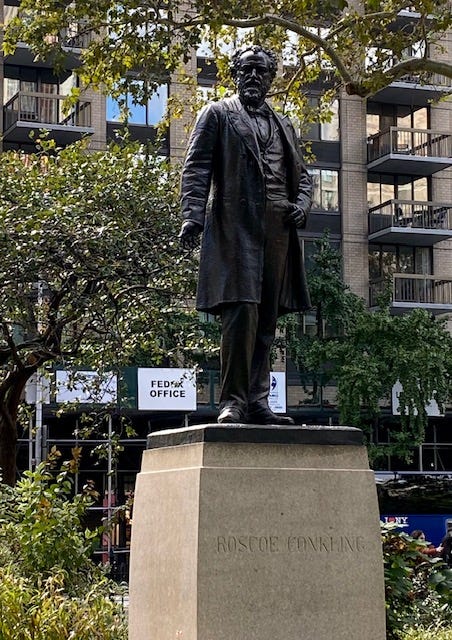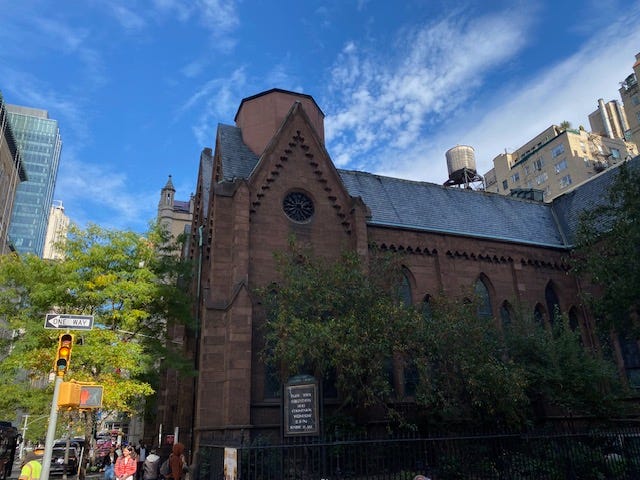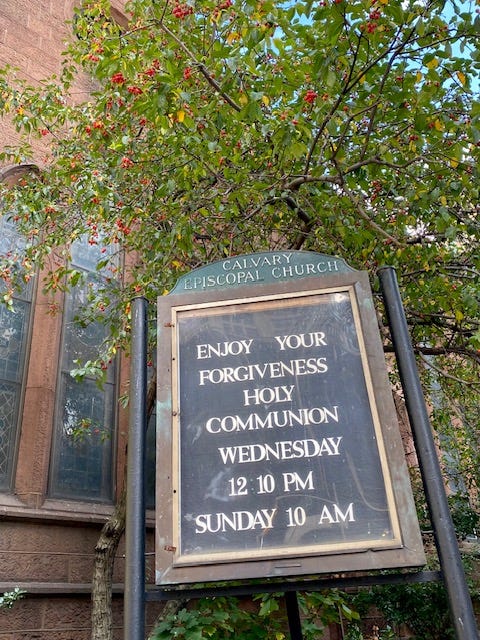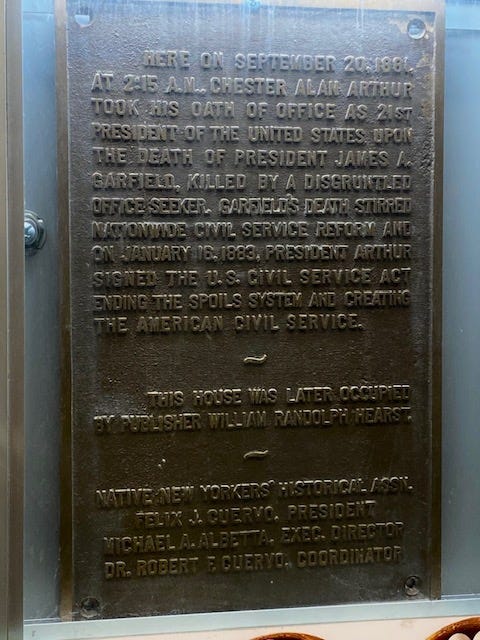New York is vertical. When you’re mostly islands, after all, there’s nowhere to go but up.1 We tend to think about New Yorkers tucked into apartments stacked neatly on top of each other.2 That overlap, however, is more compressed when you factor in time. The city becomes a multiple exposure picture where sharp political elbows slam into crashing waves of new immigrants putting their shoulder to the wheel and you find Great Men on Horses3 of history side by side in a parlor with New Yorkers moving through their day anonymously if not quietly, passing in and out of history without taking any more note of it than it takes of them, entrenched elite next to new immigrants.
Folded neatly into the neighborhood of Murray Hill on the east side of Manhattan is a slightly smaller neighborhood, like a Russian nesting doll but the innermost layer is scented with cumin and cloves. This encalve is Curry Hill. The single letter difference between the two is crucial to be able to ascertain the ratio of bars that host SantaCon to restaurants with great samosas. Lexington Avenue from 29th down past 26th is awash with amazing Indian restaurants. One of the most legendary anchors of the neighborhood is Kalustyan’s, a renowned spice store and grocery just north of East 28th on Lexington.
It’s the kind of place you could hear about from prestigious chefs and also Jimmy Breslin. It's got everything - spices as far as the eye can see! Jars of sauces if you are like me and enjoy eating but maybe not so much cooking! An amazing selection of bitters and teas! Turkish Delights so good you will finally get The Lion, The Witch and the Wardrobe! Padma Lakshmi declared it one her favorite places and if she's not a role model, I don't honestly know who is. An American president was also sworn in just about where the rows and rows of spices are laid out in alphabetical order. It was the second swearing-in in New York City4 and I’m excited to tell you all about it but to do it right we should really start with Roscoe Conkling.
Roscoe Conkling was born on October 30, 1829 in Albany. He got into politics, then got into law school, then got into the abolitionist movement. He joined the Republican party, supporting William Seward and then Lincoln for president. He was also, like DeWitt Clinton before him, so tall it made it into the historical record.5 This wasn't strictly shallow: Conkling's first term in congress was in 1859 and that December, when Thaddeus Stevens gave a particularly harsh condemnation of their southern colleagues, Conkling was said to have stood guard, since the smell of the blood of Charles Sumner was not quite out of the air yet.
He married a woman named Julia Seymour, whose brother was Horatio Seymour, who would go on to become the governor of New York and then lose the presidency to Ulysses S. Grant.6 Conkling supported Grant over his brother-in-law for president and when Grant's appointment for the position of Collector of New York fizzled out in a puddle of corruption, Conkling recommended the next pick: Chester Alan Arthur.7
Let’s meet the new overseer of the Customs House. Arthur was born in 1829, same as Conkling, but in Vermont, though his family settled in Schenectady, near Albany in Central New York. Arthur did not leave a swath of vaguely horny descriptions in his wake, but he had a reputation for being a dapper dresser, so respect. After law school, he joined the law firm of abolitionist and Arthur family friend, Erastus Culver. There he worked with John Jay8 on Lemmon v New York, a petition for the freedom of eight enslaved people who escaped their Virginian owners while they were a layover in New York during a relocation to Texas. It was a significant case that I’m going try to put in context in the simplest terms because I did not go to law school9 and don’t want to slip into Elle Woods Admissions Video territory. In November of 1852, the Lemmons arrived in New York by steamboat. An activist and former enslaved man named Louis Napoleon was tipped off that a group of enslaved people had been brought into the city and were being kept hidden in a hotel. In the final leg of New York outlawing slavery, any slave introduced to New York was to be declared free. So, the day after the Lemmons arrived in New York with two family groups in tow – Emmeline, who was 23, with her two teen brothers Louis and Edward and her two-year old daughter Amanda, and Nancy, who was 22, with her 7 year-old twin sons Louis and Edward and her 5 year-old daughter Ann—Napoleon went to court and dictated a writ of habeus corpus to the county clerk.10 He then leveraged his connections in abolitionist circles to ensure they had excellent representation. The judge declared the eight free, on the grounds that the Lemmons had chosen to come to New York but also “by the laws of nature” and the two newly-freed families started making their way north to Canada to be out of harm’s way if the appeals went against them. The appeals however, led by Arthur, also went in their favor. The Lemmons took their case up the Supreme Court but then the Civil War happened so they weren’t really available.11 Neither Jay nor Arthur took any fee for the case.
The other notable case Arthur led in his early days as young lawyer still finding his way in the Republican party was Elizabeth Jennings Graham’s. Jennings12 was a school teacher from a prominent black family in Brooklyn and on July 16, 1854 she got on segregated street car to make it to Sunday school on time. The conductor ordered her off, she refused, she was forcibly removed by cops, and started organizing a community response. She sued the Third Avenue Railroad Company13 with Arthur as her lawyer and won $250 dollars and the company’s streetcars were ordered desegrated.14
In 1859, Arthur got married to the Ellen Herndon, the cousin of a boarding house friend, in the Calvary Episcopal Church which still stands on the corner of 21st and Park Avenue South, down the street from what was recently Fotografiska15 and a block and half away from the townhouse where Theodore Roosevelt had been born the year before. I mention this church because it’s still extant, I once saw friends perform there and it was lovely, and also because I can only ever read their sign in the most whithering, passive-aggressive tone I can muster:16
The couple moved into a townhouse on Lexington Avenue and 28th, not far from the church, courtesy of family money on the bride’s side.17 The neighborhood would have been well-heeled18 but a bit east of the grand mansions that would line 5th Avenue through the Gilded Age. Completed in 1855, the five-storied home was one of nine along Lex between 28th and 29th. The upper floors of the building haven’t been changed, and the stone windowsills would have been the same for the Arthurs as they appear now. It all spoke to money and would have been considered done in very dignified taste. Mrs. Arthur favored furnishings from Tiffany,19 which also would have conveyed their money and refined style so we’re leaving them in 1859 quite comfortably ensconced. It was a home Chester A. Arthur by all accounts loved dearly and one he (and we) will be returning to but it’s not the house that would be a source of contention.
Let’s jump back to the Customs House in 1871. It covered the coast of New York state, part of New Jersey, and the Hudson. At a time when a skilled worker might make $500 a year, the position of the Collector of the Port of New York paid approximately $12,000, which would be around $440,000 today. The perk of the gig, however, was getting a percentage of fines levied. With that much territory in that busy a port, his actual take home was about $50,000 a year, a bit under the buying power of two million dollars today. Those are the stakes that made it a plum position, and a powerful carrot for motiving people to follow your lead. And it seemed to be Conkling’s carrot to bestow.20 Machine politics is based in power, and what you accumulate is determined by what you can bestow. Bear in mind Conkling became senator before the 15th Amendment was ratified, when the position was appointed by the state legislature rather than being directly elected.
So it was Conkling's support for Grant that was part of why he was less excited when the Republicans thought the corruption within his administration –even if it didn't touch Grant—was too much to bear re-election and replaced him as presidential nominee with Rutherford B. Hayes. Hayes was running against the scandals of the Grant years and pushed civil service reform. Conkling responding by calling it "snivel service reform."21 At core, though, their differences ran to their political philosophies. Conkling, by now a senator, was a Stalwart, or an old guard - the successors to the Radical Republicans like Thaddeus Stevens who supported Lincoln as president but who were angered that he did not go far enough or fast enough to protect civil rights. Hayes was Reformer, or a Half-Breed,22 and so arguing against the spoils system of appointment that kept political machines powerful in favor of a nominally, at least, more merit-based system.23 It's hard to argue against good governance, but the Stalwarts who insisted Hayes was a goody-goody who did not have the fire to punish the Confederates and enact reparations—or really meaningfully choose completing the work of emancipation and civil rights over cozying up to very literal traitors at all—were right.24 In Conkling’s case, a lot of the criticism (contemporary and after) was his relentless push to consolidate power and light corruption, which seems pretty accurate25 but also separate from what he would do with it. General McClellan made his desire for power pretty clear, but when given an army primarily used it for parades.26 Conkling, however, advocated for women’s suffrage as early as 1877. As a senator in 1875, he fought to defend Grant’s push to empower black Republicans and was so deliberate and hearty in his welcome of Mississippi senator Blanche Kelso Bruce that Bruce and his wife named their first child “Roscoe” after him. These successes and failures are largely still in the future in the last days of Grant’s administration but these were disputes, ideological and practical, shaping the fights to come.
So that takes us to the election of 1876. It’s Hayes against Democrat Samuel Tilden and it is close. Multiple states send dueling electors to Washington and Grant has to set up a congressional committee to even figure out who’s taking over. Conkling disagrees with the party line and insists that Tilden won but Hayes is declared the 19th president. By most people, anyway. Conkling declared him “Rutherfraud B. Hayes” and “His Fraudulency” which is consequentially why Conkling is pretty high on my list of which pre-internet political figures I wish could have used social media. Hayes, maybe because he cared about non-partisan civil service and certainly because he wanted to push back at Conkling’s base of power, Chester A. Arthur and another Port of New York officer were replaced when a commission led by John Jay27 said the whole Customs House was too political. Hayes would go on to start the tradition of the White House Easter Egg roll and end Reconstruction, and while I like Cadbury cream eggs as much as the next person that is not a balanced legacy.
Arthur returned to his law practice and his stately home on Lex, though not to his full family as his wife died from pneumonia in 1880. Conkling focused on party machinations in both the New York Boss of Local Politics and the Got Caught in Bed with a Former Senator’s Wife Who Gave Him a Five Minute Head Start To Run Only Because Conkling Was Unarmed senses of the word. Conkling’s scandals dinged his position, but he was still seen as the head of the Stalwarts going into the 1880 Republican convention. He and Arthur tried to renominate Grant, but after dozens of ballots, James Garfield, a kind of independent but maybe Half-Breed adjacent28 from Ohio took the nomination over Grant and William Tecumseh Sherman’s brother. In the hopes of uniting the party and not alienating Conkling, Garfield chose Stalwart and known-Conkling protegee Arthur as his running mate.29 Garfield and Arthur won in 1880 by around 10,000 votes and Garfield clashed with Conkling shortly after when he named a nemesis of Conkling’s to the head of the New York Custom House.30 When Conkling couldn’t block the confirmation, he resigned from the senate in protest.
Conkling wasn’t the guy frustrated with political appointments anyone needed to worry about, however. Charles Guiteau, an unsuccessful lawyer/bill collector/commune member, wanted a job in recompense for what he viewed as his invaluable work getting Garfield elected despite having been a self-described Stalwart and Grant supporter. When he didn’t get it, he decided God wanted him to kill the president. And so he did. On July 2nd, 1881, Guiteau waited at a train station in DC as Garfield was travelling and shot him in the back. After, he declared his reason that “I am a Stalwart.” He had nothing to do with Conkling, but it looked bad for his wing of the party anyway and ended any attempts at a comeback. Garfield was taken the White House but after doctors, a trip to the Jersey shore, and an attempted assist by Alexander Graham Bell, he went septic, went into a coma and died.
Arthur had spent this time at the townhouse on Lex. Not wanting to confuse anyone on the power structure and fearful of looking like a circling vulture, it was decided the Vice President should wait for word in New York. The telegraph came in the early hours of September 20th and Arthur took the oath of office from a New York state supreme court justice in his home, most likely in the parlor on the ground floor. He left for DC, stopping in Jersey to pay his respects to Lucretia Garfield, and began his presidency. He nominated Conkling to Supreme Court but Conkling refused it, feeling betrayed by the choices and new alliances of his one time mentee. He passed the Pendleton Civil Service Act, coming down on the side of reform after all, and he vetoed then signed the Chinese Exclusion Act. Arthur didn’t make much a push for reelection –he was terminally ill at that point and knew it—and the Republican nomination went to Conklin’s chief nemesis James Blaine of Maine,31 who would lose to Grover Cleveland. Arthur went back to 28th and Lex and died at home in 1886. Conkling would die two years later because he was too stubborn to take an overpriced cab and tried to walk home from his office on Wall Street to his home on Madison Square Park, where his statute now stands, during the Blizzard of 1888.32
Arthur’s son and his wife would stay on at 123 Lexington for a short time before it was bought in 1902 by William Randolph Hearst, who lived next door in 119 Lexington Avenue, which is now Curry in a Hurry.33 It was during Hearst’s time that it was renovated to create a storefront, as many of the contemporary townhouses along the street were. The wealthy were continuing their ongoing flight uptown. The neighborhood became Manhattan’s Little Armenia: among the waves of immigrants that defined New York’s population boom of the era were Armenian’s fleeing the genocide. That presence can still be felt in St. Vartan Armenian Cathedral on 34th and 2nd and St. Vartan’s Park on 35th and 1st.34
That was the neighborhood as Kerope Kalustyan, an Armenian from Turkey, found it when he immigrated in the 1940s. He’d had plans to import steel but ended up opening a grocery in 1944 instead, importing food and spices from south Asia and the middle east. It became important as a place to find pieces of home for many New Yorkers, to recapture a part of what was left behind. It has grown not just in square footage, though it now claims multiple store fronts and floors, but in its offerings: new communities, new tastes, new passions, and new people could all come to find themselves on the shelves.35 When Kalustyan retired, he sold the store to an employee named John Bas. When Bas decided to focus on the import side of things founding The Kalustyan’s Corporation in 1988, he sold the store to Sayedul Alam and Aziz Osmani, two cousins from Bangladesh. Alam had been in New York 20 years by then and opened Curry in a Hurry in Hearst’s old place, so there was certainly a historical echo.
Speaking of historical echoes, the plaque was unveiled by Geraldine Ferraro in 1981 after lobbying by the Native New Yorker's Historical Association and its president Felix Cuervo, who liked history and civil service. It wasn’t the first plaque, but it was the first not to be stolen, so it’s still there, tucked between the door to the apartment building and beauty shots of beans and spices.
Kalustyan’s has been described as where the melting pot of America begins, which works on a metaphorical and extremely literal level, but that cuts even deeper than the cacophony of countries you can carry around in your basket as your browse in wonder. It is a place where the New Yorkers who shape the city and the New Yorkers who have built this city can claim the same spot quirkily if not peaceably.
The plaque by the door declares the Chester A. Arthur House a landmark and the awning declares Kalustyan’s a landmark for fine specialty foods of the world. They’re both right.
It’s why the motto “ever upwards” is so apt.
Or not neatly, if you’re in one of those newish Jenga-looking buildings that I would probably be scared to walk to heavily in.
Literal and metaphorical, depending on if we’re talking outdoors or indoors.
The first and only other was George Washington on the balcony of Federal Hall.
With nicknames to match! Conkling was referred to as Lord Roscoe and Clinton was called Magnus Apollo.
So he's got something in common with Robert E. Lee. <ba dum bum, ching!> Seymour, it should be noted while we’re together in the footnotes anyway, did win New York State over Grant but he won by exactly 10,000 votes on the nose, which is so suspicious there was once a sci fi show about how even, round numbers like that shouldn't be trusted. In that case, the answer was aliens (I think), in ours its political corruption but right now, we're still at Conklin spending his early years racking up a frankly uncomfortable assortment of old timey descriptors that amount to "women want him, men want to be him/also maybe just want him."
He seemed honest and no one got mad at him, and it was the kind of job where that was about all anyone needed.
Not the one you’re thinking of. This is his grandson.
I’ve had a lot of friends on Law & Order, if that’s anything?
Napoleon was illiterate. Also, I’m just calling him Napoleon because there’s three Louises involved now.
The Lemmons did give up all claim to the eight free human beings they said they owned partly because what were they going to do? Try to fight the Civil War again? But also because a group of New Yorkers took up a donation to make restitution for the loss. This was with the intention of protecting the eight—even the judge Elijah Paine who first ruled in their favor gave $100—but it still stings that the wrong people got reparations.
We’re talking about things that happened six years before she got married so we’ll say Jennings, no disrespect meant to Mr. Graham.
Technically her father brought the suit on her behalf: she was, after all, an unmarried woman. Gross, amirite?
Lest this sound too “and that’s how New York solved racism all the way back in the 1850s,” it should be said that Jennings-now Graham and her family would flee the city ten years later in the wake of the Draft Riots.
Notable for their wonderful exhibits and their policy to let you carry your drink throughout the museum.
And that’s a lot, I assure you!
Arthur’s about to make bank, but that’s a spoils spoiler in 1859.
After all, the Roosevelts are living 8 blocks south and two blocks west at this point and the phrase “rich as Roosevelt” used to be a thing for a reason.
Tiffany also has a connection to the neighborhood, but that’s for another day, I think.
That’s the wrong metaphor but in reality are carrots that powerful a motivator without being covered in peanut butter? My dog and I both doubt it.
Something in the tone I read that in make me feel attacked even though I've never worked in civil service. I can barely even be civil.
The Half-Breed referred to the fact these politicians were so dedicated to appeasing confederates they were only Half Republican but it sure looks racist.
It should be said that part of merit was being a white, Christian man so we’re not exactly talking a utopia of fairness.
Over time, we learned to split the difference and get neither.
Apart from the spoils system he wanted to use for his own advancement, he would later argue on behalf of the Southern Pacific Railroad that corporations were meant to receive equal protection under the 14th amendment and he would know because he helped draft it.
Is this the only comparison I could have used? No, but I saw a chance to make a dig at George B. McClellan and I took it.
Still the grandson. I, uh, guess they were the kind of co-workers who weren’t friends.
Again, the political term of the time, not a comment on his parentage.
Only a partial success as Conkling told Arthur not to take the post.
To be fair, Conkling racked up a fair number of nemeses.
James Blaine of Maine was plainly Conkling’s Bane. How do you like them (Big) apples, Professor Higgins?
As someone who still doesn’t have an Uber account, I really identify with that except I’ve always assumed I’d die after walking into traffic because I was turned around looking a good dog who had passed me.
I’m assuming Orson Welles and a whole lot of unions would agree this is an upgrade.
After Vardan Mamikonian, who fought to prevent the forced conversion of Armenians to Zoroastrianism.
Roland Foods followed a similar pattern, expanding their offerings to fit the needs of new communities looking for old flavors, part of a DIY immigration infrastructure.










